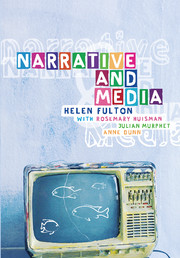Book contents
- Frontmatter
- Contents
- Figures and tables
- Contributors
- Acknowledgements
- 1 Introduction: the power of narrative
- Part 1 The basics of narrative theory
- Part 2 Film as narrative and visual mode
- Part 3 Television: narratives and ideology
- 10 The genres of television
- 11 Television news as narrative
- 12 Aspects of narrative in series and serials
- 13 Soap operas and sitcoms
- Part 4 Radio and print journalism
- Part 5 Popular print culture
- Glossary
- Bibliography
- Index
11 - Television news as narrative
Published online by Cambridge University Press: 05 June 2012
- Frontmatter
- Contents
- Figures and tables
- Contributors
- Acknowledgements
- 1 Introduction: the power of narrative
- Part 1 The basics of narrative theory
- Part 2 Film as narrative and visual mode
- Part 3 Television: narratives and ideology
- 10 The genres of television
- 11 Television news as narrative
- 12 Aspects of narrative in series and serials
- 13 Soap operas and sitcoms
- Part 4 Radio and print journalism
- Part 5 Popular print culture
- Glossary
- Bibliography
- Index
Summary
I think that the same process is involved in the construction of any event televisually … You constantly draw on the inventory of discourses which have been established over time. I think in that sense we make an absolutely too simple and false distinction between narratives about the real and the narratives of fiction.
(Stuart Hall 1983)Recognition of a text as belonging to a particular genre can help readers (listeners, viewers) make judgements about the ‘reality status’ of the text, most fundamentally whether it is fictional or non-fictional. News is a very recognisable non-fiction genre. That it is non-fiction does not mean it will not use narrative, however, despite the fact that we might associate narrative (storytelling) with the imagined and invented. Television news is not only a popular source of information but also it enjoys a high degree of credibility. Public opinion polls and ratings surveys have shown that since the 1990s television news has become both the primary and the most believed source of news for a majority of viewers, in countries such as the USA, the UK and Australia.
This reflects the phenomenon referred to in chapter 10, observed by Ellis (1992) and Williams (1990), that television images appear to be ‘really happening’ in the present moment. The characteristic visual and audio codes and narrative structures of television news work together to construct such news values as truth and balance, as well as to convey authority and immediacy.
- Type
- Chapter
- Information
- Narrative and Media , pp. 140 - 152Publisher: Cambridge University PressPrint publication year: 2005
- 4
- Cited by



